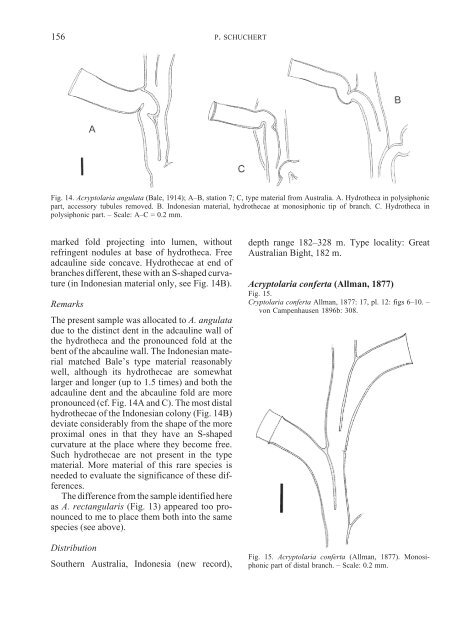Hydroids (Cnidaria, Hydrozoa) of the Danish expedition to
Hydroids (Cnidaria, Hydrozoa) of the Danish expedition to
Hydroids (Cnidaria, Hydrozoa) of the Danish expedition to
Create successful ePaper yourself
Turn your PDF publications into a flip-book with our unique Google optimized e-Paper software.
156<br />
marked fold projecting in<strong>to</strong> lumen, without<br />
refringent nodules at base <strong>of</strong> hydro<strong>the</strong>ca. Free<br />
adcauline side concave. Hydro<strong>the</strong>cae at end <strong>of</strong><br />
branches different, <strong>the</strong>se with an S-shaped curvature<br />
(in Indonesian material only, see Fig. 14B).<br />
Remarks<br />
The present sample was allocated <strong>to</strong> A. angulata<br />
due <strong>to</strong> <strong>the</strong> distinct dent in <strong>the</strong> adcauline wall <strong>of</strong><br />
<strong>the</strong> hydro<strong>the</strong>ca and <strong>the</strong> pronounced fold at <strong>the</strong><br />
bent <strong>of</strong> <strong>the</strong> abcauline wall. The Indonesian material<br />
matched Bale’s type material reasonably<br />
well, although its hydro<strong>the</strong>cae are somewhat<br />
larger and longer (up <strong>to</strong> 1.5 times) and both <strong>the</strong><br />
adcauline dent and <strong>the</strong> abcauline fold are more<br />
pronounced (cf. Fig. 14A and C). The most distal<br />
hydro<strong>the</strong>cae <strong>of</strong> <strong>the</strong> Indonesian colony (Fig. 14B)<br />
deviate considerably from <strong>the</strong> shape <strong>of</strong> <strong>the</strong> more<br />
proximal ones in that <strong>the</strong>y have an S-shaped<br />
curvature at <strong>the</strong> place where <strong>the</strong>y become free.<br />
Such hydro<strong>the</strong>cae are not present in <strong>the</strong> type<br />
material. More material <strong>of</strong> this rare species is<br />
needed <strong>to</strong> evaluate <strong>the</strong> significance <strong>of</strong> <strong>the</strong>se differences.<br />
The difference from <strong>the</strong> sample identified here<br />
as A. rectangularis (Fig. 13) appeared <strong>to</strong>o pronounced<br />
<strong>to</strong> me <strong>to</strong> place <strong>the</strong>m both in<strong>to</strong> <strong>the</strong> same<br />
species (see above).<br />
Distribution<br />
Sou<strong>the</strong>rn Australia, Indonesia (new record),<br />
P. SCHUCHERT<br />
Fig. 14. Acryp<strong>to</strong>laria angulata (Bale, 1914); A–B, station 7; C, type material from Australia. A. Hydro<strong>the</strong>ca in polysiphonic<br />
part, accessory tubules removed. B. Indonesian material, hydro<strong>the</strong>cae at monosiphonic tip <strong>of</strong> branch. C. Hydro<strong>the</strong>ca in<br />
polysiphonic part. – Scale: A–C = 0.2 mm.<br />
depth range 182–328 m. Type locality: Great<br />
Australian Bight, 182 m.<br />
Acryp<strong>to</strong>laria conferta (Allman, 1877)<br />
Fig. 15.<br />
Cryp<strong>to</strong>laria conferta Allman, 1877: 17, pl. 12: figs 6–10. –<br />
von Campenhausen 1896b: 308.<br />
Fig. 15. Acryp<strong>to</strong>laria conferta (Allman, 1877). Monosiphonic<br />
part <strong>of</strong> distal branch. – Scale: 0.2 mm.

















